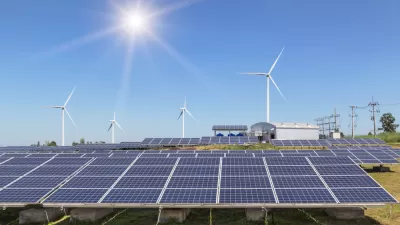A bill to phase out coal-powered electricity by 2030 is advancing in the legislature. It would also double the state's renewable portfolio standard to 50 percent by 2040 for Oregon's two largest utilities.
"The bill, dubbed the Clean Electricity and Coal Transition Plan [House Bill 4036], passed through the Oregon House on February 15 by a vote of 39-20, and would require both PacifiCorp and Portland General Electric (PGE) — Oregon’s two largest, investor-owned utilities — to stop using coal in their energy mix by 2030," writes Natasha Geiling, climate reporter for ThinkProgress.
"The Clean Electricity plan was crafted by bringing diverse parties to the table -- the investor owned electric utilities, environmental and consumer organizations, and the renewable energy industry -- and the vote reflected the wide support of the bill," states the Feb. 15 Sierra Club press release.
While the largest source of power (43 percent) in the Beaver State is entirely renewable and carbon-free, not all hydropower qualifies under the 2007 Renewable Portfolio Standard (RPS) [see hydropower provisions [(PDF)], which "requires the largest utilities in Oregon to provide 25 percent of their retail sales of electricity from newer, clean, renewable sources of energy by 2025," according to the RPS webpage. HB 4036 would increase the renewable mix to 50 percent by 2040 for PGE and Pacific Power.
California's Renewable Portfolio Standard, adopted last year, requires all utilities to generate 50 percent of electricity from renewable sources 10 years earlier—by 2030. Hawaii passed even stronger mandates in legislation last year calling for 100 percent renewable electricity by 2045, while Vermont set a requirement of 75 percent renewable power by 2032, according to the U.S. Energy Information Administration.
"The proposal applies only to Pacific Power and Portland General Electric, who together serve about 70% of Oregon’s electricity needs," according to a fact sheet [PDF] provided by proponents of the plan, which includes both utilities and environmental groups. "It does not change existing requirements on consumer-owned utilities."
But the strongest part of the bill is phasing out coal power, not only the largest source of greenhouse emissions in the United States, but also one of the largest contributors to air pollution. And with President Obama's Clean Power Plan Rule in jeopardy as a result of a recent Supreme Court ruling, it may take more state action to reduce the use of coal power.
“While Oregon has just one coal-fired power plant in the state set to retire in 2020, we are not generating all the coal in the state that we use, but we are consuming it. This bill takes responsibility not just for what we generate but what we consume,” Amy Hojnowski, senior campaign representative with the Sierra Club, told ThinkProgress.
Natural gas supplies 12 percent of the current energy mix. "Solar and wind, by contrast, make up a much smaller slice of the pie, accounting for just .02 percent and 5.2 percent respectively," notes Geiling,
Oregon law calls for achieving "greenhouse gas levels that are at least 75 percent below 1990 levels," according to Keep Oregon Cool.
Had utilities not agreed to the plan, environmentalists were ready to go to the ballot with two initiatives that would have required the utilities to meet similar goals.
Hat tip to Fred Heutte, Sierra Club International Climate and Energy
FULL STORY: Oregon Set To Pass One Of The Most Ambitious Environmental Bills In Decades

Depopulation Patterns Get Weird
A recent ranking of “declining” cities heavily features some of the most expensive cities in the country — including New York City and a half-dozen in the San Francisco Bay Area.

California Exodus: Population Drops Below 39 Million
Never mind the 40 million that demographers predicted the Golden State would reach by 2018. The state's population dipped below 39 million to 38.965 million last July, according to Census data released in March, the lowest since 2015.

Chicago to Turn High-Rise Offices into Housing
Four commercial buildings in the Chicago Loop have been approved for redevelopment into housing in a bid to revitalize the city’s downtown post-pandemic.

New Park Opens in the Santa Clarita Valley
The City of Santa Clarita just celebrated the grand opening of its 38th park, the 10.5-acre Skyline Ranch Park.

U.S. Supreme Court: California's Impact Fees May Violate Takings Clause
A California property owner took El Dorado County to state court after paying a traffic impact fee he felt was exorbitant. He lost in trial court, appellate court, and the California Supreme Court denied review. Then the U.S. Supreme Court acted.

How Urban Form Impacts Housing Affordability
The way we design cities affects housing costs differently than you might think.
City of Costa Mesa
Licking County
Barrett Planning Group LLC
HUD's Office of Policy Development and Research
Mpact Transit + Community
HUD's Office of Policy Development and Research
City of Universal City TX
ULI Northwest Arkansas
Town of Zionsville
Urban Design for Planners 1: Software Tools
This six-course series explores essential urban design concepts using open source software and equips planners with the tools they need to participate fully in the urban design process.
Planning for Universal Design
Learn the tools for implementing Universal Design in planning regulations.






















